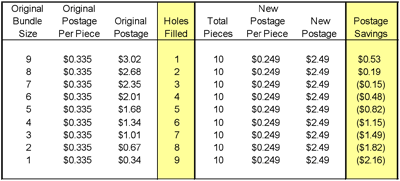It’s time to cheer up.
Yes, catalog mailers were slammed again in the May 2007 rate increase. But there’s a way to maintain current circulation levels at only a portion of that new cost.
What many people forget is that the USPS also increased the number of postage tiers. The goal was to reward mailers preparing their mailings just the way the postal service likes them.
What’s this mean to you? First, you can improve your return on investment by keeping or adding names that receive the maximum discount. Or, you can drop names when postage costs make those records unprofitable to mail.
Add-a-name
The first step in getting maximum postal benefit is to create mail-file density. This can be done via traditional add-a-name strategies or by co-mailing.
The goal in implementing either (or both) of these strategies is to place as many books as possible in the highest postal rate tiers. Many mailers have added names—they know that filling one hole is always a winning proposition.
But you can fill two holes. The proof is in the following table.

One more tip: Remember to include the paper and printing costs associated with each added name.
The next step is to consider the incremental profit these add-a-name records will generate. The stronger the names are, the more holes can be filled.
But where do you find these names? Many mailers turn to older house-file names that are relatively strong—but not quite good enough to mail on their own. The premise is that the postage savings provided by filling holes offsets the marginal performance of these names, making them profitable to mail.
Other catalogers draw on the purchase data of the Abacus Alliance or one of the other co-ops. By adding these high-quality names, they improve their return and lower marketing expenses.
This added dimension improves the potential return from each mailing and helps lower marketing expenses.
Drop-a-name
But you just can’t keep adding names—sometimes you have to drop them.
Some may fall into more costly tiers. The postage penalties can be so great that they offset any contribution the names may make..
This is especially true for names that are expected to be marginal performers to begin with. Take a look at all of the names in the lower, more expensive tiers, and evaluate whether or not they are worth mailing.
Let’s you have a breakeven of $0.80 for each book mailed at the CRRT tier, and that you have decided to mail 10,000 names from a list with a projected sales per book of $0.90. Here’s a look at how these names may fall into their respective postal tiers:

What can you learn from this? You can identify the names that fall below breakeven. These records are found in the postal rate tiers at $0.363 and greater. The conclusion: That Thus 1,500 books may be taken out of the mail stream because they are too costly to mail.
Marketing decisions must be based on financial soundness. It makes sense to drop names that will fall below breakeven after factoring in the additional cost of postage because of the recent postal hike. And don’t stop there—replace them with good names that will be mailed at the CRRT rate.
All this will help you maximize the return on each campaign dollar invested. The net benefit may be tens or hundreds of thousands of dollars a year.
Jack Sturn is vice president of client services for I-Centrix, an East Greenbush, NY-based data management firm.